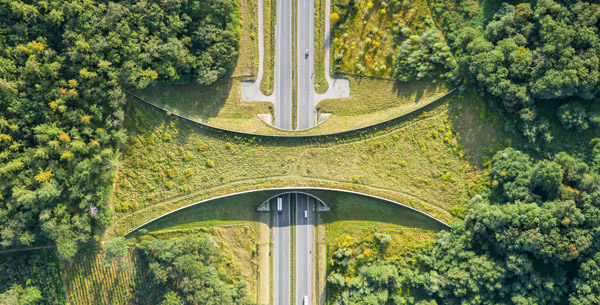Due to the impact that roads can have on the population, mitigation measures that help limit and prevent fragmentation, increase genetic diversity and achieve biodiversity net gain (NGB) are vital needs, explains Terry Wilkinson, applications engineer of roads of ACO Water Management.
The construction industry is in a unique position where its actions can directly affect levels of wild biodiversity in the UK.
According to a 2021 Royal Society for the Protection of Birds (RSPB) report, the UK is the worst G7 country for wildlife loss due to human activity.
Transport infrastructure such as road and rail has a detrimental impact on wildlife populations across the UK. Between 2010 and 2020, transportation infrastructure has caused a variety of problems, including habitat loss, pollution, and fragmentation. In addition to this, mortality from traffic accidents has also increased.
In the last 40 years, one in seven species of UK wildlife has become extinct or is threatened with extinction.
Natural England also found that 40% of our most important habitats and 30% of our rarest species are still in decline. Hedgehogs are a clear example of the impact that transport infrastructure is having on the environment. The number of hedgehogs in the UK has halved since 2000, with experts claiming the population has shrunk from 30 million to a million since the 1950s.

The Environment Law 2021
To protect against further damage to our ecosystems, the Environment Act, which became law in November 2021, will put environmental principles into practice. The law aims to protect species and peatlands while increasing biodiversity and the amount of forest.
One aspect of the law is that it will measure biodiversity net gain (NGB) by using a Natural England metric that was launched in July 2021. This metric will allow developers and associations to measure the amount of NGB achieved. The toolkit can be used by any development project, consent body or landowner who needs to calculate the net gain of biodiversity in England.
Amphibious Super Highways
One group of animals that needs immediate care and protection are amphibians.
During their construction and use, roads are responsible for considerable loss and fragmentation of biodiversity with amphibians. Whenever possible, mitigation measures should be implemented to limit negative impact on local habitats.
Mitigation measures may include:
- Materials: Materials must be adapted to the ecology of the species. For example, residue on the surface of standard concrete can be fatal to amphibians, so polymer concrete material should be used.
- Habitat Connectivity – It is important to create a secure link between habitats and aquatic areas through the use of guide walls and crossing tunnels. These allow animals to cross the road safely.
- Roadside Curbs and Ravines: Amphibians can become trapped in traditional roadside ravine beds because they have a natural inclination to move along any vertical barriers in their path. A wildlife curb with a gap can help protect amphibians due to its escape ladders or mesh material.
- Construction Areas: Temporary fencing around construction areas can help prevent animal incursion into the site and mitigate any hazards to site activity. This is vitally important during the breeding and spawning seasons.
In certain situations, mitigation measures cannot be used, leaving road developers with no choice but to use compensation measures. Compensation measures to convert remaining habitats into suitable climates for biodiversity are vital if other mitigation measures cannot be used.
When designing highways, the Road and Bridge Design Manual guide outlines the general requirements for highway biodiversity design (LD 118) and the procedures to follow when assessing and reporting the environmental effects of a proposed scheme in accordance with the Environmental Impact Assessment directive (LA 104).
Sustainable drainage systems
Sustainable Drainage Systems (SuDS) are also a crucial aspect to consider when protecting biodiversity.
Under Chapter 6 of the Habitat guidance in the CIRIA SuDS Manual (C753), it states that any new SuDS scheme must link to other habitats to help build and improve their connectivity. By doing this, problems associated with habitat loss and fragmentation within urban areas can be avoided.
To conclude, lessening the negative impact that transportation infrastructure has on wild biodiversity and habitats is essential to ensure that animals, such as the hedgehog, are protected from extinction.
By including wildlife protection solutions in highway designs, the impact and intrusion faced by wildlife is minimal thanks to simple changes and inclusions. Ensuring that mitigation measures are implemented allows animals to continue living in their habitats without suffering the consequences of human urbanization.
